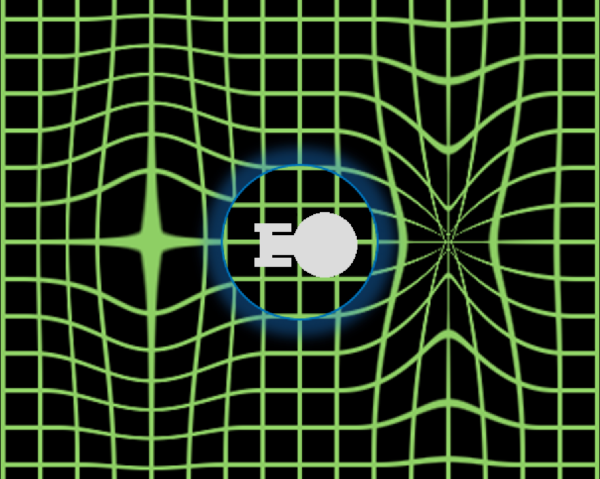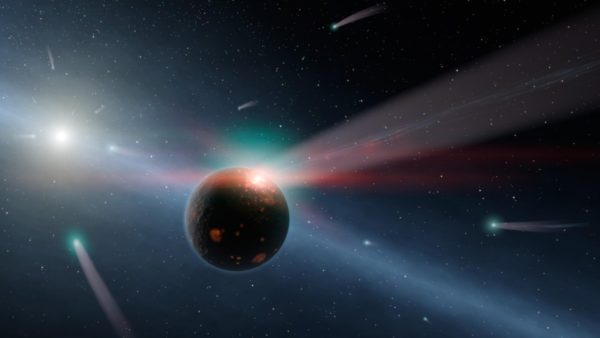"Its continuing mission: to explore strange new worlds, to seek out new life and new civilizations, to boldly go where no one has gone before." -Star Trek, in many incarntions
When Star Trek debuted 50 years ago, we didn’t know that there would be regions of the Universe that were forever inaccessible to humanity, nor that there would be galaxies permanently unreachable to us, even if we managed to develop near-light-speed travel technology. Yet thanks to the existence and dominance of dark energy today, that’s exactly the case. The only workaround, it appears, would be to develop faster-than-light travel.
 A warp field from Star Trek, which shortens the space in front of it while lengthening the space behind it. Image credit: Trekky0623 of English Wikipedia.
A warp field from Star Trek, which shortens the space in front of it while lengthening the space behind it. Image credit: Trekky0623 of English Wikipedia.
But with the physical possibility of the Alcubierre solution to General Relativity, which would enable warp drive, this might actually render these distant, unreachable regions someday traversable. Not only that, but a whole slew of other “physical impossibilities” would suddenly become possible, enabling us to perform acts that physics without warp travel would simply never allow.
- Log in to post comments


I understand that the traveling object isn't exceeding the speed of light because it is at rest relative to the "bubble" of spacetime it's within, and it's the bubble that's moving. But what I don't understand is why the bubble itself can propagate faster than light.
Put another way, when a gravity wave is produced by an accelerating object, it moves away from its source at c. Why does the warping of spacetime created by an Alcubierre drive go faster?
@ Bunny
hmm.. very interesting question. Made me think about what I know from GR. I hope Ethan address it..... my five cents would be that a gravitational wave is a distortion in spacetime... and that distortion propagates at the speed of light. In the warp drive... you are contracting the thing in front and expanding expanding in the back.. and thus "riding the gradient" so to say... that contraction might very well be limited to speed of light.. or might not....like I said.. great question :) I know that there is no speed limit imposed on spacetime itself. It can expand in principal faster then "c".. inflation being one example. What makes grav. wave different is a question.
One thing I don't understand is why the Alcubierre Drive doesn't warp time when it warps space, similar to what happens in the rest of special and general relativity. Since space and time are supposed to be inseparable, it seems like any attempt to contract or expand space would also contract or expand time.
I'd feel a lot better about the possibility of a warp drive, or any other form of FTL, if there were anything in nature, anything at all, that traveled faster than light. (At least without having to be 15 billion light years away from the observer.)
SelfAwarePatterns: "I’d feel a lot better about the possibility of a warp drive, or any other form of FTL, if there were anything in nature, anything at all, that traveled faster than light. (At least without having to be 15 billion light years away from the observer.)"
Quantum mechanical entanglement will provide instantaneous communication without regard to distance no matter how large that distance may be.
High temperature Bose condensation is the KEY. If two systems that share a common Bose condensation condition can be separated with one condensation transceiver in the control room and one in the spacecraft, then the control room can direct the control and discovery function of the spacecraft in real time using remote quantum mechanical based control.
In the longer term instantaneous QM based teleportation of matter and energy might be configured.
Thanks axil. But from everything I've read, communication via entanglement isn't possible. The explanation that clicked for me is that entanglement is like both of us receiving a copy of a specific issue of a newspaper at a previously agreed upon time. Even if we're light years apart, both of us know what's in the other's paper, but it doesn't give us any way to communicate about it.
That said, I'm not going to claim I understand the actual physics, so my understanding might well be flawed.
No, quantum entanglement cannot enable faster than light communication. One good analogy is that we have a bag containing two marbles, one red and one blue. I take one, and put it in my own bag without looking at it. I then go on an Alcubierre Drive spacecraft and go to, say the galaxy cluster CL J1001+0220, 11.1 billion light-years away. I then look at the marble I have and find that it's blue. You look at your marble and find that it is red. Have I then instantaneously communicated to you across 11.1 billion light years the fact that my marble is blue? Of course not.
An amplitude modulated signal could be established where the sender system created and destroyed an amount of entanglement on a periodic basis. The requirement is that this amount of entanglement be reflected in the receiver. Information is carried in the amount of entanglement not in the values carried by the entanglement.
If information can be manipulated in a quantum computer, that information might be transferred over distance, that being the number of qbits not the content of the qbits.
@ Axil
you can't use entanglement for FTL communication. period. Any transfer over any distance will still be carried at c, not faster. You can't change the ammount of entanglement. And every measurement you make is made on a new system. Entangle, measure.. done. No repeats. New entanglement, new measurment, new system.
http://phys.org/news/2013-04-quantum-internet-solid-state-network.html
'Quantum Internet': Towards realization of solid-state quantum network
The less than the speed of light relativistic requirement is paid when the two quantum transceivers are separated at under the speed of light as the spacecraft moves away from the control room.
Next, the coherent increase in entanglement between each quantum communication transceiver is the feature of the quantum network that is critical to verify. The entangled qubits need to reproduce themselves like microbes that divide. Polaritons might be able to increase their entanglement with others of their kind.
This feature is seen in LENR when single powered master reactor can drive n unpowered slave reactors to produce increased coefficient of performance (COP).
There is a ton of money going into research into quantum computers and networks, and even more into entangled communications, because no connection path is needed between sender and receiver.
"'Secondly, teleportation offers the possibility of sending information in a completely secure way. With teleportation, the information does not travel through the intermediate space and therefore cannot be intercepted."
The N.S.A will like that very much...meaning lots of R&D. Where there is money, there is hope.
Warp may not violate physics, but if it requires negative mass, that might not exist in our universe. Or the amount and density of energy required might be beyond the grasp of any conceivable technology, perhaps by factors of billions. Most likely it will remain a dream.
Matter and energy are equivalent as Einstein proved. Negative vacuum energy is generated by positive vacuum energy to keep vacuum energy zero on the average.
For more explanation see
http://www.bibliotecapleyades.net/ciencia/negativeenergy/negativeenergy…
Your first paragraph.... "When Star Trek debuted 50 years ago, we didn’t know that there would be regions of the Universe that were forever inaccessible to humanity, nor that there would be galaxies permanently unreachable to us, even if we managed to develop near-light-speed travel technology. The only workaround, it appears, would be to develop faster-than-light travel.". Makes no sense at all..... was it EVER THOUGH we would be able to reach any other stars without some kind of FTL propulsion?
There was never a moment on Star Trek where they didn't need a warp drive to travel to other stars.
"But what I don’t understand is why the bubble itself can propagate faster than light."
It doesn't, in its own frame of reference, and within the local bubble. Indeed it's that extent of local bubble that is the source of warp drive's odd physics AND its great expense (energetically, and even in requirements for being possible).
Think about wormholes, too. From the universe's POV you just went faster than light, yet you also traveled no distance (in our 3d space).
Warp is another way to cheat out of having to move through 3d space.
Ta2025,
After Star Trek came out, it was discovered that the expansion of the universe is accelerating. It was previously believed that this expansion was slowing down. In a universe where the expansion is slowing, it is perfectly conceivable that a spacecraft travelling at less than c could reach any point in the universe. It might take a hideously long time to get there, but it could in fact get there. You'd probably need something like a self-sustaining "generation ship" to do it, but the point is that given enough time, any point in the universe could be reached.
With accelerating expansion, however, there are points in the universe that are not reachable by a slower than light spacecraft EVER. No amount of time will allow the craft to reach these points because (loosely speaking) the expansion is carrying these points away from us at a speed greater than c.
Since vacuum fluctuation produces virtual particles and an energy deficit, could a warp drive work by somehow "pushing" the virtual particles to the rear of the ship and leaving the energy deficit in the front? You couldn't produce a surplus of negative energy but a temporary local reversal, the way an air conditioner produces cold air by overall generating more heat.